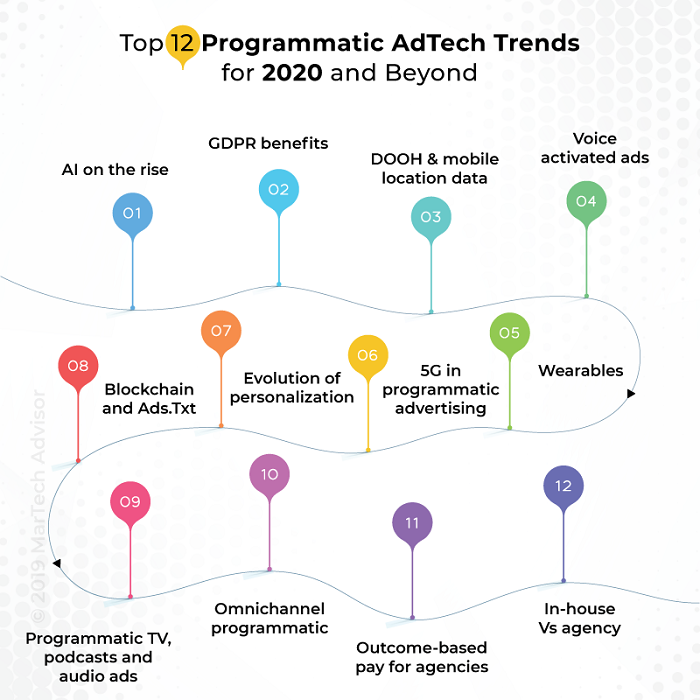Nov 05 2019
Programmatic advertising is on a disruptive ride with new technologies such as artificial intelligence, machine learning, voice search and digital OOH attracting most advertisers. With 5G promising a push to programmatic on one hand and the implementation of GDPR posing new challenges, there’s a lot more that marketers need to watch out for in the space. Here we track the top trends you need to follow in the programmatic Ad Tech space for 2020 and beyond.
Programmatic advertising is by far the most crucial component of advertising technology – one that is keeping the entire adtech fraternity on a vigil for what’s coming next. It is set to be the default media trading method in the coming years. According to Zenith’s ‘Programmatic Marketing Forecasts’ report, programmatic ad spend will reach $98 billion, amounting to 68% of the global digital media ad spend by 2020.
Introduction of technologies such as artificial intelligence (AI), machine learning (ML) and 5G are going to make programmatic advertising more efficient, while the entry of newer advertising channels such as Digital Out Of Home (DOOH), podcast and audio programmatic advertising, voice-activated ads, smart devices, and AR/VR not only gives marketers more choices but also provides a more engaging, personalized experience for consumers. It is a far cry from the TV ads of yore that segmented customers based on demographics alone!
Before 2020 comes knocking, here are 12 trends that will pave the path for new-age digital ad planning.
1. AI in programmatic advertising
Audience management strategy is already a maturing space, with many marketers having connected the dots between audience selection, targeting, campaign optimization and measurement. The deluge of data to help marketers target the right people with the right message, in the right channel and device, at the right time means that the use of artificial intelligence (AI) powered technologies will only continue to rise.
Artificial Intelligence (AI) and Machine Learning (ML) help, by sifting through huge volumes of data in real time to find patterns, predict outcomes and suggest the next best action to each individual customer in order to move them further in their buying journey. It is not just the scale and speed that AI can bring to the process of marketing that makes it so powerful – it is also the intelligence it brings that would be impossible for a human to match at that scale and speed.
Marketers will see AI analyze customer behaviour in real-time basis multiple data points such as gender, age, location, preferences, device, platform, previous history and more. It will be able to map user data with ad viewing metrics such as when or where an ad is played, for what duration and so on, to suggest when to place an ad where and in what format. The ability of AI to identify buyer patterns accurately and then place ads accordingly, helps increase overall ad effectiveness, thereby reducing the cost of customer acquisition.
For instance, IBM’s AI based bot Watson is being continuously developed for optimized programmatic media buying and is already popular in the US and UK. In one of its official blogs IBM’s VP of Marketing Analytics, Ari Sheinkin shared that the results of programmatic media buying by Watson show a stunning 71% reduced Cost Per Click (CPC).
AI based programmatic advertising has captured the attention of advertisers significantly over the last two years. A 2018 Deloitte survey of over 1,100 US executives from early adopters of AI, reported that 82% of them saw a positive return on investment for their AI initiatives. This indicates the increasing faith in AI in programmatic advertising which will strengthen further over the next year.
Learn More: Top 5 Programmatic Advertising Platforms for 2020 and Beyond
2.GDPR ultimately proves to be advertisers’ friend, not foe
After the announcement of General Data Protection Regulation (GDPR) in Europe last year, what looked like a setback to advertisers is gradually turning out to be beneficial. The regulations around seeking consent and protecting the privacy of user data, initially looked limiting to adtech experts, but is resulting in cleaner and more reliable data over time.
The scale of data may have seen a downfall, but the quality of available data has increased tremendously. This trend is going to strengthen further over the years with digital platforms adding forms and policies in line with data privacy norms. As the GDPR website says, “CIOs must ensure that they have watertight consent management processes in place, whilst CMOs require effective data rights management systems to ensure they don’t lose their most valuable asset – data.”
First-party data, which is also the cleanest and most reliable source for a marketer has become more important, and hence brands now have the onus of directly and transparently communicating with customers on how beneficial or safe it is for them to share their details. While high quality publishers or already trusted brands may not face too many challenges with this, newer brands will need to push harder for establishing trust with the customers.
Ultimately, cleaner data will mean lesser targets but more relevant and interested ones. This will in turn establish a connect of mutual trust between the publisher and the user, thereby allowing the same to the advertisers with their consumers. Here, programmatic provides the assurance of reaching out to only those prospects who will not just find the ads relevant but are also more likely to make a well-informed buying decision.
3. Digital Out Of Home (DOOH) combined with mobile location data
While out-of-home advertising is one of the oldest and most traditional advertising channels, its digital avataar- digital OOH or – DOOH combined with mobile location data has the potential to redefine how marketers can address the crucial last mile between home and store, or online and offline. Mastering this promises a direct impact on the speed and scale of conversions when it comes to closing the loop between advertising and buying.
While DOOH itself lends well to the programmatic buying model, both in terms of efficiency and scale, the real trends to watch in the space for 2020 are:
- Integrated ‘home to out-of-home’ programmatic advertising approach, which will deliver a more seamless experience for customers.
- integration between DOOH and the use of mobile locational data to drive conversions in the offline world
For example, Publicis Media had partnered with geospatial technology company Vistar Media, and identity resolution provider LiveRamp for a DOOH campaign for the clothing brand REI. With this, REI activated a cross-channel DOOH and mobile media campaign to reach customers and prospects in places where they were most likely to spend time. As a result, they saw a 7% increase in purchase intent, along with a 14% lift in brand awareness. REI’s retail outlets also experienced a 3.6 times rise in store traffic.
The coming years will see a drastic shift from merely buying or trading outdoor ad spaces to estimating audience data for targeting relevant audiences with ads where they most likely are, at any given point of time. Advertisers can expect more from their budgets, as programmatic in DOOH will allow targeted audience planning and buying, with increased efficiency, brand safety and measurement.
As it gets more measurable with first party and third party data from companies, for media buyers, programmatic DOOH is one good-for-all medium that will deliver both brand (experiential) and performance marketing.
4. Voice-activated ads go beyond in-home smart devices
Adoption of voice-based, in-home smart devices has been on the rise. Last year, Amazon reported that it had sold over a 100 million Alexa-enabled devices and that customers spoke to Alexa tens of billions more times in 2018 compared to 2017. A few years ago, Gartner predicted that by 2020, 30% of web browsing sessions will be done without a screen, through voice-first browsing.
Isn’t it turning out to be true? We often ask our voice assistants to help us with a specific product we want to purchase, and listen to it list out relevant products or platforms from where we can buy what we want. A recent survey by VoiceBot.AI revealed that 25% of respondents say everyday household items are the most ordered through voice-assistants, followed by apparel and then entertainment and games. The survey was conducted on 1,203 US consumers.
Programmatic advertising has a critical role to play in helping marketers optimize these ad spaces across in-home smart devices, to in-store and on-apps audio ad opportunities. Additionally, OOH audio advertising solutions such as Vibenomics allow brands to connect with consumers through in-store background ads, broadcasting over speakers installed at shopping stores, ads in elevators and taxis, waiting room CCTVs etc.
5. Wearables will augment programmatic advertising
One of the ‘Black Mirror’ episodes – ‘The Entire History of You’ – shows people wearing a “grain” or a memory implant behind their ear, which records everything they do, see and hear. Using a remote, a user can play back their memories directly to their eye or to a video monitor anytime they want.
Although not to the extent we saw in the Black Mirror episode, wearables already collect data on location, lifestyle, health metrics and more. Imagine the kind of insights that will be available to the advertising industry, if wearables were to become this advanced, while still respecting the privacy of the individual. Though it may still sound a bit intimidating or even invasive to some, with GDPR regulating data collection and usage norms, availability of such data with user consent will open-up huge opportunity for advertisers to target the strongest prospects, in the right place and at the right time with the most relevant messages.
The market penetration of smart watches has also grown multifold over the last few years. A 2019 report by Strategy Analytics claims that global smartwatch shipments grew to a remarkable 44% year-on-year to reach 12 million units in the second quarter this year.
This trend is already followed by programmatic advertising making its way into this new medium. For instance, FitAd helps advertisers deliver automated promos that run banners to consumers on their Sony or Samsung watches. As the wearable ecosystem grows, programmatic adtech will bring in greater opportunities with its inherent ability to track, monitor and optimize campaigns based on more accurate user and ad consumption data.
6. 5G will catalyze all programmatic advertising
The cellular bandwidth landscape is expecting a boost with the commercial launch of the 5th generation of cellular mobile communications i.e. 5G. The bandwidth of 5G is expected to be over 100 gigabits per second, which is 100 times more than its predecessor — 4G.
The high bandwidth of 5G will not only allow websites or videos to load faster but will enable the adtech ecosystem to perform faster, delivering or placing ads at the right mediums and at the right time with lightning fast speed.
The high-speed and no-lag buffering will encourage a significant rise in time spent on videos on all mobile devices. This in turn will be another strong reason for advertisers to deliver more high resolution, 4K ads to their target audience.
By 2024, the adoption of 5G based adtech is predicted to grow to 1.4 billion!
This means, ample scope for programmatic advertising to be able to run sharper, more interactive ads across mediums, without any lags.
5G will augment other technologies and mediums such as augmented reality enabled ad displays, virtual reality without the heavy headsets, and innovative new digital outdoor ad mediums. Marketers must gear up to create and deliver content in multiple formats and across devices, making use of the speed and latency that 5G promises.
Learn more on the impact of 5G for marketers.




